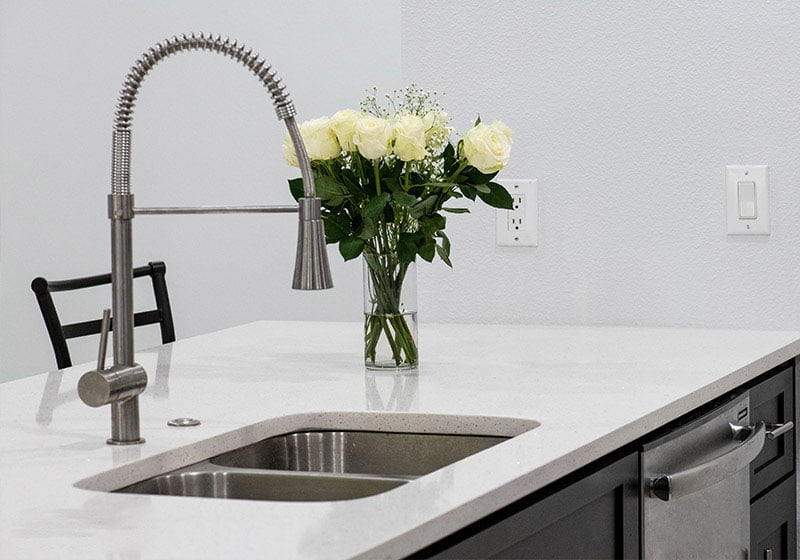Did you know that, as per the statistics, 24% of all homeowners in the United States choose granite countertops for home remodeling, making it the second most popular material for kitchen counters behind quartz?
Granite countertops are a great investment for your kitchen or bathroom. The granite countertop industry is large, so it’s easy to get confused about the various brands, grades, and ratings. It’s also hard to know exactly what the difference is between them.
Well, we’ve got you covered. Because we will discuss the granite grading system in this blog, we will also look into factors that influence this grading.
Granite Grading System
Granite is the most widely used material for countertops due to its great quality, aesthetics, and reasonable price. But most people are unaware that granite is classified into three grades:
- Level 1 granite
- Level 2 granite
- Level 3 granite
Let’s go over all three granite levels in depth.
Level 1 Granite: Entry-Level Granite
The lowest grade of granite is level 1 granite, sometimes known as entry-level granite, commercial-grade granite, or builders-grade granite. This is the least expensive type of granite, but it still has its uses in kitchens.
This type of granite frequently has very basic patterns and uniform colors. It is often around 3/8 inch thick and cut thinner than other granite grades. Also, Having some acceptable imperfections in granite is natural, but grade 1 granite can have some imperfections in its grain pattern.
Grade 1 Granite is frequently imported from China. It’s typically an entry-level grade, which means it will not last as long as higher-quality materials. However, for homeowners who prefer granite but are on a tight budget, level 1 granite countertops are a perfect option because they are less expensive than the other granite grades.
Level 2 Granite: Middle-Grade Granite
Grade 2 normally has an average thickness of 3/4 inch and significantly more unique designs and colors than an entry-level slab. This kind typically comes from Brazil and India. You may also find this type has fewer imperfections than grade 1 granite.
Level 3 Granite: High-Grade Granite
High-grade granite is any type of granite with a grade level of 3 or higher, and it is one of the best and most beautiful stones currently available. This level 3 granite is more durable and thicker than mid-level granite and is often 3/4 inch thick or more. Additionally, it has peculiar veins, hues, and patterns, giving it a unique appearance.
This high-grade granite is often supplied from Brazil or India and has a distinctive appearance. However, this level 3 granite could be more pricey.
Granite Grading System: What Are The Key Factors?
When it comes to granite grades, various factors count. Granite is classified by its color, visual appearance, thickness, and minerals it contains. The other important factors include,
- Thickness of Granite
Granite is a hard, porous stone that’s been mined for centuries. Massive slabs of granite emerge from the earth. Companies have carved these huge slabs into thinner slabs to make them easier to handle. However, some manufacturing companies cut the slabs thinner to get more slabs. The granite slab’s durability is decreased when it is sliced into thinner slices. Thicker granite is stronger and, therefore, of a higher grade.
The Place of Origin
Granite’s quality isn’t always related to where it comes from. However, the price is affected by the country of origin. Even when comparing two slabs of granite of identical quality, the country of origin significantly affects the cost. Due to lower labor expenses, granite from Brazil and Italy tends to be more expensive, whereas China often produces the least expensive granite stones.
- Granite’s Visual Appearance
Granite’s visual appearance also influences its grading. It’s a fact that there are some acceptable imperfections in granite, like natural fissures and pits. But there is a difference between the natural flaws and the low quality. Any defects, such as scratches, dents, or chips, indicate a lower quality of the granite. This type of damage would not be found in a high-quality slab.
- Porosity
High-quality granite resists liquid absorption. If a slab of granite is overly porous and enables liquids to seep within, it is a low-quality slab that will wear out quickly.
Why It’s Important to Understand the Granite Grading System
The most important thing when looking at these granite grades is understanding what each offers and how they differ. Knowing these granite levels will help you decide whether you should opt for level 1 granite countertops or level 3 granite countertops based on your style preference and budget.
Conclusion
Undoubtedly, granite is durable, versatile, and looks great. But how can you be sure you’re picking the right one? Well, take this burden off your shoulders because, when it comes to kitchen countertops, you can trust Edstone. Their experts can help you pick the best granite level for your countertops.





